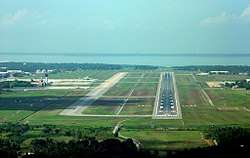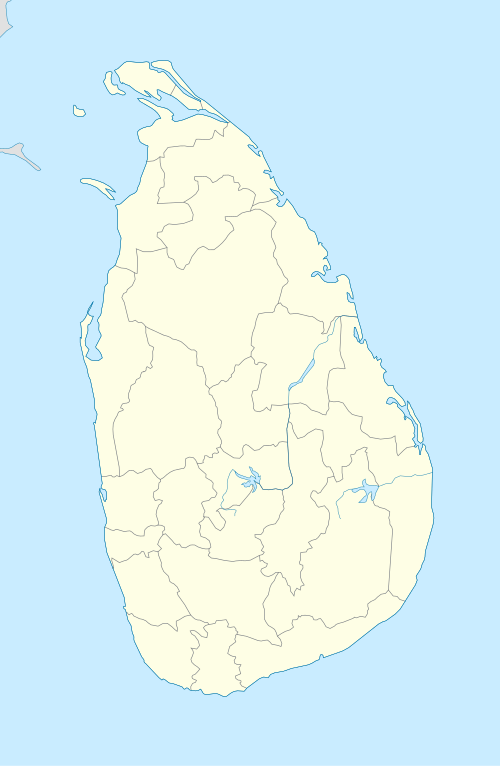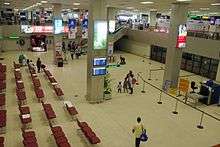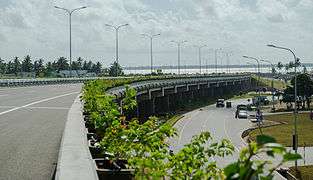Bandaranaike International Airport
| Bandaranaike International Airport බණ්ඩාරනායක ජාත්යන්තර ගුවන්තොටුපළ பண்டாரநாயக்க பன்னாட்டு வானுர்தி நிலையம் | |||||||||||||||||||
|---|---|---|---|---|---|---|---|---|---|---|---|---|---|---|---|---|---|---|---|
 | |||||||||||||||||||
 | |||||||||||||||||||
| Summary | |||||||||||||||||||
| Airport type | Public / Military | ||||||||||||||||||
| Owner | Government of Sri Lanka | ||||||||||||||||||
| Operator | AASL[1] | ||||||||||||||||||
| Serves | Colombo | ||||||||||||||||||
| Location | Katunayake, Negombo, Sri Lanka | ||||||||||||||||||
| Hub for | |||||||||||||||||||
| Time zone | SLST (UTC+05:30) | ||||||||||||||||||
| Elevation AMSL | 26 ft / 8 m | ||||||||||||||||||
| Coordinates | 07°10′52″N 79°53′01″E / 7.18111°N 79.88361°ECoordinates: 07°10′52″N 79°53′01″E / 7.18111°N 79.88361°E | ||||||||||||||||||
| Website |
www | ||||||||||||||||||
| Map | |||||||||||||||||||
 CMB/VCBI Location of airport in Sri Lanka | |||||||||||||||||||
| Runways | |||||||||||||||||||
| |||||||||||||||||||
| Statistics (2017) | |||||||||||||||||||
| |||||||||||||||||||
Bandaranaike International Airport (Sinhalese: බණ්ඩාරනායක ජාත්යන්තර ගුවන්තොටුපළ; Tamil: பண்டாரநாயக்க பன்னாட்டு வானுர்தி நிலையம்), colloquially known as Katunayake Airport and Colombo International Airport, (IATA: CMB, ICAO: VCBI) is the main international airport serving Sri Lanka. It is named after former Prime Minister SWRD Bandaranaike and is located in a suburb of Negombo, 20 miles (32.5 km) north of the commercial capital Colombo. It is administered by Airport and Aviation Services (Sri Lanka) Ltd and serves as the hub of SriLankan Airlines, the national carrier of Sri Lanka, and domestic carrier Cinnamon Air. The other airport serving the city of Colombo is the Ratmalana Airport, primarily serving domestic destinations.
History

The airport began as a Royal Air Force airfield in 1944 during the Second World War, RAF Station Negombo. In 1957, Prime minister S. W. R. D. Bandaranaike removed all the British Military airfields from Ceylon (Sri Lanka), and the airfield was handed over to the Royal Ceylon Air Force (RCyAF) and renamed Katunayake; part of it still remains a military airfield. In 1964 Anil Moonesinghe, the Minister of Communications, started the building of a new international airport to replace Ratmalana, with Canadian aid. The airport was completed in 1967, and Air Ceylon, the national carrier, began international operations from it using a Hawker Siddeley Trident and a leased British Overseas Airways Corporation (BOAC) British Aircraft Corporation (BAC) VC-10. It was named after former Prime Minister SWRD Bandaranaike, in 1970. It was renamed Katunayake International Airport in 1977, but was changed back to Bandaranaike International Airport in 1995.
On 7 November 1971 the first Boeing 747 landed at the airport. The Boeing 747-200B was operated by Condor carrying German tourists from Frankfurt. In the early 1990s the position of the airport's runway (04/22) was shifted northward and the old runway was made into a taxiway for departing and arriving aircraft. Airport expansion projects have recently been undertaken at the airport under the Stage 1, Phase II Expansion Project. A pier with eight aero-bridges opened in November 2005. A new terminal with an additional eight gates are proposed to be built under Stage II of the Phase II Expansion Project. Construction of the new Stage II, Phase II Expansion Project is expected to commence in April 2017 and is expected to be completed by 2020.
On 7 May 2007 the Sri Lankan Government decided to shift some military aviation operations out of the space adjoining the airport to SLAF Hingurakgoda, thus paving the way for more civilian operations. As part of the airport development program, a passenger train service was launched between the Airport and Colombo Secretariat Station, in June 2010. Plans were also unveiled to extend the Colombo-Katunayake airport express train to Ratmalana International Airport.[3] The airport is used by Emirates as an alternative emergency airport for its Airbus A380 aircraft.[3][4] On 9 January 2012, an Airbus A380-800 operated by Emirates flight EK 413 from Sydney landed at Bandaranaike International Airport. This was the first time in history that an Airbus A380 had landed in a Sri Lankan airport. EK 413 had taken-off from Sydney en route to Dubai, but needed a refueling stop. Originally planned to refuel at Singapore, it was decided to land in Colombo instead. The exact cause as to why the A380 needed to refuel is not known.[5]
Bandaranaike International Airport is equipped with 18 double jetway gates in preparation for airlines introducing the Airbus A380.
SriLankan Airlines is the largest airline operating at the airport, with a fleet of 25 Airbus aircraft based at Colombo and providing scheduled services to Europe, Middle East, India, South East Asia, the Far East and Australia.
An Emirates A380 aircraft, which is one of the largest aircraft in the world, received a warm welcome at the Bandaranaike International Airport (BIA), Katunayake on 14 August 2017. This one-off flight proved confidence in the BIA's newly resurfaced runway, enabling the A380 to land there. This is a significant milestone for the aviation industry in Sri Lanka and the BIA. By coincidence, it was piloted by a Sri Lankan.[6][7]
Facilities

Terminals
Bandaranaike International Airport (airport code CMB) at Katunayake, Sri Lanka, is 27 kilometers north of the island nation's capital of Colombo. Thirty airlines currently serve the airport's over 9.80 million annual passengers. . The airport has three passenger terminals. Terminal 1 is the current international terminal, built in 1967, Terminal 2 is the new international terminal, which is expected to be completed in 2019, and Terminal 3 is the new domestic terminal, which opened in November 2012. The airport's new Silk Route lounge recently opened, expediting the customs process for Commercially Important Passengers.
- Terminal 1 opened in 1967 and is the oldest and largest terminal in the airport. It has 12 gates. The arrival and departure areas are separated horizontally. All international flights currently use this terminal, until Terminal 2 opens in 2019. The terminal consists of a main terminal building directly connected to one concourse which houses all the gates. Once past security, passengers proceed through the long, arm-shaped concourse housing gates 6–14. On the upper level of this concourse, there are two lounges. In the main body of the terminal is SriLankan Airlines' "Serendib Lounge", and the Palm Spirit lounge. This area has duty-free shops, a tea shop, a cafeteria, a smoking lounge, and day-rooms & showers.
- Terminal 2 is planned to open in 2019. It is planned to have 8 gates, with arrival and departure areas separated vertically. A new terminal with eight more gates is proposed to be built under Stage II of the Phase II Expansion Project. Construction of the new Stage II, Phase II Expansion Project was commenced in April 2017 and is expected to be completed in 2019. A new pier with eight boarding gates and 14 passenger boarding bridges, with an additional gate comprising two passenger boarding bridges for the Airbus A380, will be included in the proposed new development.
- Terminal 3 opened in November 2012 and handles all domestic flights. Its arrival and departure areas are separated horizontally.
- The Cargo Terminal opened in October 2009 and handles all cargo flights. Its arrival and departure areas are separated horizontally.
Aprons
- Apron Alpha: It is the oldest existing apron at the airport. It has 9 parking bays including 5 remote parking bays and 4 boarding bridge equipped bays. It can handle 4 Boeing 747 aircraft and 5 Airbus A330-200 aircraft at once.
- Apron Bravo: It has 8 parking bays, including 4 remote parking bays and 4 boarding bridge equipped bays. It can handle any 8 wide-body such as an Airbus A330, Airbus A340, Boeing 777 or Boeing 747 at once. The 4 remote bays will be converted into 4 Airbus A380 capable boarding bridges under the Stage II development project.
- Apron Charlie: It has 8 parking bays, all of them are currently remote bays. It can handle any 8 wide-body such as an Airbus A330, Airbus A340, Boeing 777 or Boeing 747 at once. The remote bays will be converted into 8 Airbus A380 capable boarding bridges under the Stage II development project. It is the only apron that is currently capable handling the Airbus A380-800. It has been used by Emirates Airbus A380s thrice.
- Apron Delta: It has 4 parking bays capable of handling narrow-body aircraft.
- Apron Echo: It is currently under construction, it will have 17 parking bays.
Runway
The Bandaranaike International Airport has a single runway (04/22), with an asphalt surface. The take-off and landing distances are 3,441 m and 3,350 m respectively.[8] In addition, the government has decided to invest on a second runway at the airport, enabling the A380 to land in Colombo. There is also a plan to build another taxiway to handle the A380 in the future. In addition, Phase II of the BIA expansion project is to have a second runway, also able to accommodate the A380, with another taxiway to the second runway.
Expansion projects

The airport is undergoing resurfacing of its runway. Future projects include a second runway to support the Airbus A380, a further eight passenger gates, a domestic terminal, a five-storey car-park, and a five-star hotel neighbouring the airport. Construction of the new approach channels to the airport will begin in April 2017, and expected to be completed by 2020 .[9]
A new split-level passenger terminal building, which separates arrivals and departures vertically, a new pier with eight boarding gates, and 14 passenger boarding bridges, with a dedicated gate comprising two passenger boarding bridges for the new Airbus A380, will be included in the proposed new complex. There would also be a remote apron and an additional nine parking stands to ease air traffic movement. There would be a tax-free apparel shopping mall at the Katunayake BOI Zone to attract more business visitors to Sri Lanka. The mall is to be adjacent to the arrival terminal and connected by a sky bridge.
The second stage will involve the acquisition of 600 hectares of public land, the construction of a runway capable of accommodating new-generation airplanes, an aircraft repair and maintenance center, an arrival and a departure terminal, a shopping arcade, a cargo complex connected to the airport by rail and a multistory car park. Under the Development Project Phase II, Stage 2, a second passenger terminal and a required utility for second terminal will be constructed. Work will also be carried out to expand the terminal, aircraft parking apron, and public utilities. The existing airport terminal will be converted to a domestic and regional terminal, when the new complex is ready. A two tier passenger terminal with arrivals and departures physically separated as found in most modern airports will also be constructed. A rapid exit to the Colombo – Katunayake Highway will be provided directly from the terminal. Stage 2 itself is to be implemented in two stages and the first stage is scheduled to be completed by 2020.
The project has been divided into 2 Packages and the bidding has been completed for both Packages.
The construction work of Package B –“Remote Apron and Taxiways” commenced in April 2017 and the work is expected to be completed by October 2019.
The bids for Package A- “Terminal building and associated works” is under evaluation and it is expected to commence the construction work by November 2017 with the selection of the main contractor and the work is expected to be completed for the operation by the end of year 2020.
Project phases and construction
The second phase of the expansion project is being carried out with Japanese assistance and is expected to be completed by 2019.
- November 2007 to August 2014 – Development stage of Phase II
- The new design, submitted in July 2014, provided a green terminal, utilizing the sun with more eco-friendly concepts incorporated
- On 7 Sep 2014, the Japanese premier launched stage 2 of the second phase of the BIA development project on his arrival at the airport, which is being funded by the Japanese Government.
- 2017–2020, the construction for the new terminal will commence in April 2017 and will be completed in 2019.[10]
Airlines and destinations
Passenger
Cargo
| Airlines | Destinations |
|---|---|
| Cathay Pacific Cargo | Chennai, Hong Kong |
| Qatar Airways Cargo | Doha, Karachi, Lahore, Kochi, Thiruvananthapuram |
| SriLankan Cargo Operated by FitsAir | Bangkok–Suvarnabhumi, Bengaluru, Chennai, Doha, Dubai–International, Kochi, Mumbai, Malé |
| Turkish Airlines Cargo | Istanbul–Atatürk |
Ground transportation
Bus
A coach service operates every 15 minutes from the terminal to Colombo via E03 Colombo – Katunayake Expressway, with a travel time of around 30 minutes.
Car

E03 Colombo – Katunayake Expressway is a new high-speed road linking the airport to the city of Colombo with a travel time of around 20 minutes and a few minutes to the city of Negombo. The airport taxi service operates a counter in the arrival Lobby with a fleet over 600 vehicles.
Rail
A high-speed rail system is proposed to connect from the city of Negombo to city of Colombo via BIA airport by an electrified high-speed rail link to Colombo Fort where it will link to the proposed Colombo Monorail.
Sea
Cinnamon Air operates scheduled seaplane flights from Seeduwa Dadugam Oya near the airport using DHC-6-100 aircraft.
SLAF Katunayake
| SLAF Katunayake | |
|---|---|
| Katunayake, Western Province | |
| Type | Cantonment |
| Site information | |
| Controlled by | Sri Lanka Air Force |
| Site history | |
| Built | 1944 |
| In use | 1956 – present |
In 1956 with the departure of the RAF from RAF Negombo, the Royal Ceylon Air Force took over and renamed the station RCyAF Katunayake. With the construction of the Bandaranaike International Airport, major portion of the air base was taken over. However the Sri Lanka Air Force remained and expanded its air base adjoining the International Airport. At present it is the largest SLAF station in the country and is the airfield for several flying squadrons as well as ground units. The SL Air Force Hospital is also based at SLAF Katunayake.
In March 2001, on the 50th anniversary of the Sri Lanka Air Force, the airfield was presented with the President's Colours.
Lodger squadrons
Accidents and incidents
- On 4 December 1974, Martinair Flight 138, a Douglas DC-8 flew into the side of a mountain while on landing approach to Bandaranaike. The pilots had mistakenly believed that a power station near a mountainous area was the airport. All 191 passengers and crew on board were killed.[22]
- On 15 November 1978, Icelandic Airlines Flight 001, a Douglas DC-8 on a charter flight, crashed into a coconut plantation while on approach to Katunayake, Sri Lanka for a refueling stop. 184 out of 264 people on board were killed.
- 3 May 1986 – Air Lanka Flight 512. In an operation carried out by the Liberation Tigers of Tamil Eelam (LTTE or Tamil Tigers), a bomb in an Air Lanka (now SriLankan Airlines) Lockheed L-1011 TriStar 100 exploded while passengers where boarding for a short-hop flight to Malé, in the Maldives. 14 passengers were killed, and the aircraft was written off.[23]
- 24 March 2000 – An Antonov 12BK operated by cargo carrier Sky Cabs crashed due to lack of fuel. It crashed into two houses killing four people on the ground and six of the eight crew on board.[23]
- 24 July 2001 – Bandaranaike Airport attack. 14 members of the LTTE Black Tiger suicide squad infiltrated Katunayake air base and destroyed eight military aircraft on the tarmac. Moving to the civilian airport, they destroyed two Airbus aircraft and damaged three others. Seven government personnel were killed.[23]
- 4 February 2004 – An Ilyushin 18D cargo plane operated by Phoenix Aviation and chartered by the Sri Lankan cargo company Expo Aviation was landing in Colombo on a flight from Dubai. The copilot incorrectly set the altimeter and the landing gear contacted the surface of the sea, 10.7 km (6.6 mi) short of the runway. A belly landing was performed 50 m (160 ft) to the right of the runway.[23]
- 8 September 2005 – While a Saudia Boeing 747 taxied for takeoff on an international flight from Colombo to Jeddah, Saudi Arabia, air traffic controllers received an anonymous telephone call concerning a possible bomb on the aircraft. The crew was informed about this call and elected to perform an emergency evacuation. As a result of the evacuation, there were 62 injuries among the 420 passengers and 22 crew members. One of the passengers died as a result of injuries received during the evacuation, and 17 passengers were hospitalized. No explosive device was found during a search of the aircraft.[24]
- 25 March 2007 – At 00:45 the Tamil Tigers bombed the Sri Lanka Air Force base adjoining the international airport. Three Air Force personnel were killed and 16 injured when light aircraft dropped two bombs, although no aircraft were damaged. Passengers already on aircraft were disembarked and led to a shelter, while others trying to reach the airport were turned away and approach roads closed. The airport was temporarily shut down following the incident, but normal flights resumed at 03:30.[25]
See also
References
- ↑ "Airport and Aviation Services (Sri Lanka) Limited".
- ↑ "Civil Aviation Authority of Sri Lanka: Annual Report 2015".
- 1 2 "Bandaranaike International Airport, Katunayake, Sri Lanka". airport-Technology. Retrieved 4 February 2011.
- ↑ Sirimane, Shirajiv (14 February 2010). "Airbus A380 to touch down at BIA". Sunday Observer. Archived from the original on 16 February 2010. Retrieved 10 January 2012.
- ↑ Sandaruwan, Miyuru. "Airbus A380 Touches Down in Sri Lanka for the first time". Airline Industry Review. Retrieved 10 January 2012.
- ↑ "Emirates One-Off A380 Lands in Colombo". Emirates.
- ↑ "Emirates lands one-off A380 in Colombo - Emirates Airline". Emirates. 21 August 2017 – via YouTube.
- ↑ "CMB - Colombo [Bandaranaike Intl], 1, LK - Airport - Great Circle Mapper". www.gcmap.com. Retrieved 2017-03-13.
- ↑ Ministry of Ports and Aviation Medium Term. Infrastructure Development Programme Microsoft PowerPoint 10.5 MB 13 January 2008
- ↑ Kumarasinghe, Uditha. "RESURFACING OF RUNWAY AT BIA: AIRLINES GIVEN FOUR OPTIONS". Sunday Observer. Retrieved 17 July 2017.
- ↑ Aeroflot resumes Colombo service in late-Oct 2018 Routesonline. 21 August 2018.
- ↑ "China Southern adds Sri Lanka service from Sep 2017". airsrilanka. Retrieved 28 July 2017.
- ↑ 2018, UBM (UK) Ltd. "Edelweiss outlines additional new long-haul routes in NW18".
- ↑ http://www.dailymirror.lk/154098/Emirates-to-suspend-two-flights-between-Singapore-and-Colombo
- ↑ 2017, UBM (UK) Ltd. "SriLankan Airlines expands India network from July 2017".
- ↑ "SriLankan Airlines makes progressive changes to its Winter 2018 schedule". www.srilankan.com. Retrieved 19 September 2018.
- ↑ "SriLankan Airlines outlines A321neo S17 service". Routes Online. Retrieved 11 April 2017.
- ↑ "SriLankan Airlines resumes Melbourne service from Oct 2017". Routesonline. Retrieved 29 May 2017.
- ↑ https://timesofindia.indiatimes.com/city/visakhapatnam/sla-to-withdraw-colombo-vizag-services-from-oct-27/articleshow/65971885.cms
- ↑ "Thomas Cook UK adds Sri Lanka charters in W18". Air Sri Lanka Forum. Retrieved 14 April 2018.
- ↑ 2016, UBM (UK) Ltd. "Thomson Airways Schedules Boeing 787-9 W16 Nordic Operations".
- ↑ "Aviation-Safety PH-MBH accident description page". Aviation-safety.net. 4 December 1974. Retrieved 19 October 2011.
- 1 2 3 4 Accident history for CMB at Aviation Safety Network
- ↑ "Wayback Machine" (PDF). 29 September 2011. Archived from the original (PDF) on 29 September 2011.
- ↑ "Situation at Katunayake brought totally under control [5th Lead]". Defence.lk. Archived from the original on 21 May 2013. Retrieved 19 October 2011.
External links
![]()